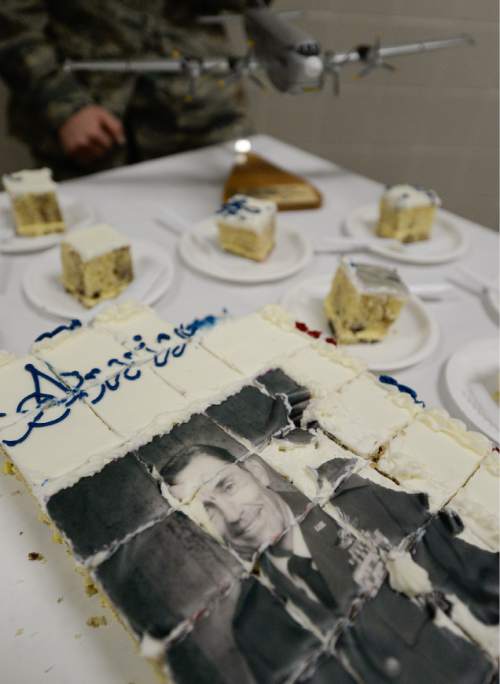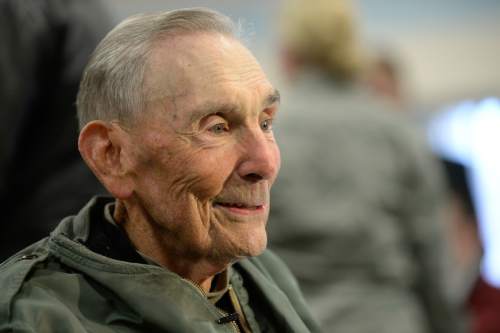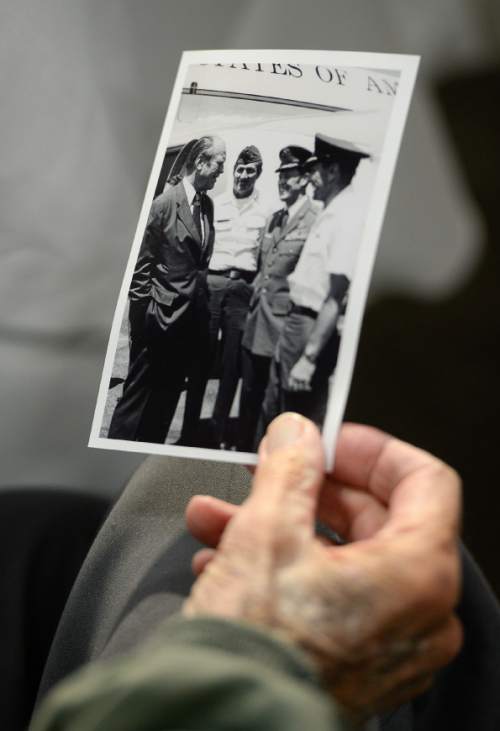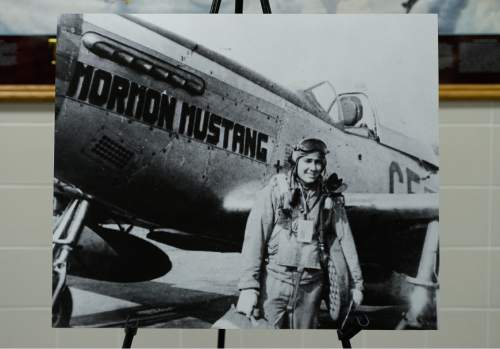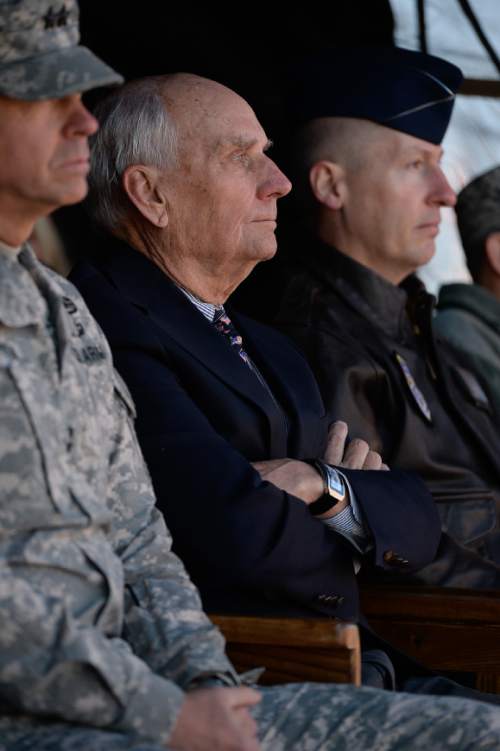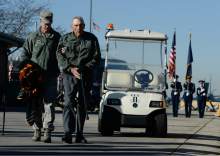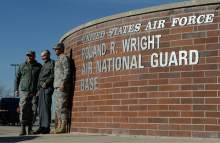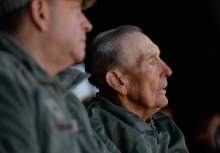This is an archived article that was published on sltrib.com in 2015, and information in the article may be outdated. It is provided only for personal research purposes and may not be reprinted.
Roland Wright, the World War II fighter pilot who flew the "Mormon Mustang" and went on to become a brigadier general, died Monday. He was 96.
His son, Gordon Wright, said Friday that Wright's health deteriorated in the past month as he suffered from a variety of ailments. Services will be held Monday in Salt Lake City, the son said, and is to include a fly-over by three P-51 Mustangs, including a replica of the Mormon Mustang — Wright's World War II aircraft.
Wright gave that name to his P-51 shortly after arriving in Britain with the Army Air Corps in 1944.
"He was proud of being a Mormon and the 'MM' just kind of went together," Gordon Wright said Friday.
But fame for the name didn't arrive until 2001. That year, the book "Saints at War: Experiences of Latter-Day Saints in World War II" had a cover photo of Wright and other men sitting on the wing of his P-51. "Mormon Mustang" is visible in lettering on the side of the airplane.
After World War II, Wright became one of the first airmen to join the fledgling Utah Air National Guard. With it, Wright was called to duty during the Korean War, training pilots to fly the F-86 Sabre in Clovis, N.M. Wright was not deployed to Korea, but in the F-86 he won a gunnery competition three years in a row.
Wright was deployed to Vietnam during the war there and flew a transport plane with the Utah Air National Guard.
He retired from the Utah Air National Guard in 1976 with the rank of brigadier general.
Last year, the National Guard base adjacent to Salt Lake City International Airport was renamed the Roland R. Wright Utah Air National Guard Base. Wright was on hand at a ceremony as a parachute was pulled away to reveal the new sign at the base's entrance.
Roland Robinson Wright was born March 30, 1919, in Blackfoot, Idaho, the fifth of six children born to farmers Cyril and Esther Robinson Wright. He loved nature, including birds, and gave them credit for an early interest in flight.
In a 2009 interview with the LDS-owned Church News, Wright recalled how when he was 14, barnstormers came through town offering airplane rides for $10. Wight saved his money, took a flight and landed with a desire to be a pilot.
In 1940, he left on a mission for The Church of Jesus Christ of Latter-day Saints in the Pacific Northwest. (The spreading war canceled church plans to send him to New Zealand and Australia.) Near the mission's end, he heard about the attack on Pearl Harbor.
He enlisted in the Army Air Corps and was accepted into pilot training. Wright was assigned to the 357th Fighter Group of the Eighth Air Force. The group flew from airfields in Britain and had a stable of pilots that included a young Chuck Yeager. The 357th is considered one of the most successful fighter squadrons of the war, destroying 500 to 600 German airplanes, depending on which account you read.
Wright shot down three enemy aircraft during World War II. Gordon Wright said his father shot down two German propeller fighters and one jet. The episode with the jet in January 1945 earned Wright the Distinguished Flying Cross.
According to an account Wright gave in a 2000 interview with Benjamin Bahlmann on file in the L. Tom Perry Special Collections Library at Brigham Young University, Wright and another P-51 were in a dogfight with a German Messerschmitt Me 262 — the world's first operational fighter jet. It was faster and more maneuverable than the P-51s. When the German couldn't score a quick victory, he turned toward home before running out of fuel.
Wright and the wingman pursued. The jet pilot led his pursuers over German positions that began firing flak from the ground.
The wingman was hit and his P-51 burst into flames. Wright followed his training and turned into the discharged flak burst.
Wright spotted the German fighter as it was in the middle of turning.
"And I guess he figured by then I was down." Wright told Bahlmann. "I don't know, but I caught him on the turn. Got him with a good burst and he ran into the ground."
By then Wright was out of oxygen and low on fuel. Another P-51 pilot who had been watching from a higher altitude led the Mormon Mustang to a snow-packed airfield he spotted in France. Wright didn't know if the airfield was controlled by German or Allied forces, but his engine quit as he landed.
French resistance had taken the airfield two days earlier. Wright waited four days for someone to bring him fuel.
Wright corresponded during the war with Marjorie McDonough. They married in the Salt Lake Temple on March 21, 1946.
Wright earned a bachelor's degree in political science and then a law degree from the University of Utah. He practiced business law and became a partner with the firm Clyde, Mecham and Pratt.
Meanwhile, Wright continued rising up the ranks of the Utah Air National Guard, eventually becoming its commander. He also served on committees at the Pentagon concerned with the status of national guard and reserve forces.
Gordon Wright said the "Saints at War" photo and book helped spark interest in his father's time as a pilot. People from all over the world, Gordon Wright said, contacted Wright wanting to hear stories of his days in a P-51.
"He was getting calls up until the day he died," Gordon Wright said.
Marjorie Wright died in 1994. Wright's survivors include a daughter, Shannon Huntington; sons, Richard and Gordon Wright; 10 grandchildren and five great grandsons.
A viewing will be held from 6 to 8 p.m. Sunday at Larkin Sunset Lawn, 2350 E. 1300 South in Salt Lake City and again from 10:30 to 11:45 a.m. Monday at the Monument Park 2nd Ward, 1005 S. 2000 East in Salt Lake City. Services will be at noon Monday at the ward house, followed by interment at Wasatch Lawn Memorial Park, 3401 S. Highland Drive.
Twitter: @natecarlisle



